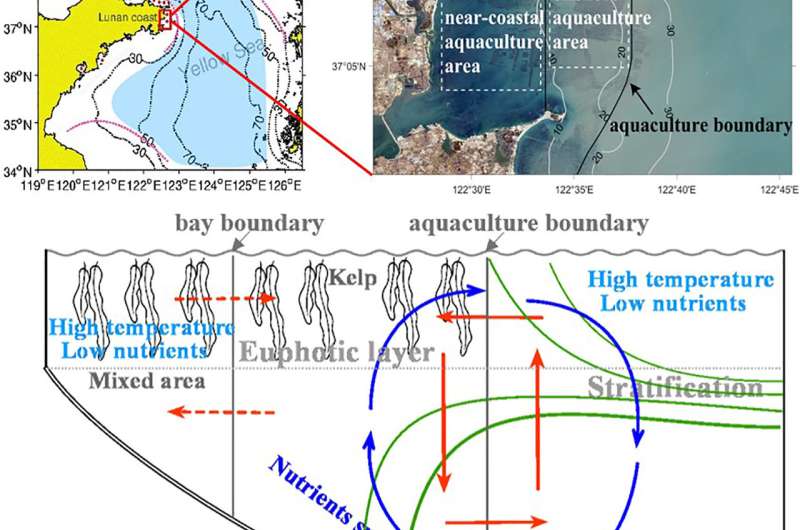Coastal aquaculture can reduce nutrient transport

Coastal aquaculture produces many types of seafood, including fish, shellfish, and aquatic plants. An ongoing challenge, however, is understanding the impact of excessive aquaculture on nutrient levels in the surrounding waters. Using a combination of field observations and high-resolution mathematical simulations, He et al. investigated the impact of aquaculture at Sanggou Bay, located off China's coast in the Yellow Sea.
The main aquaculture technique used in this area is suspended aquaculture, where species of kelp and shellfish hang beneath the water's surface on ropes. In addition to a near-coastal aquaculture area within Sanggou Bay, which goes as deep as 10 meters, there is also an offshore aquaculture area that extends to depths between 20 and 30 meters. By sampling from stations over the whole region, the team found that nutrient concentrations are highest outside the aquaculture area, especially in the near-bottom layer.
To explore the effect of suspended aquaculture on hydrodynamics, the researchers ran numerical experiments with and without aquaculture-induced friction as part of their mathematical model. Their results showed that at the outer boundary of the aquaculture area, aquaculture-induced friction transforms onshore currents in lower layers into offshore currents, which could reduce the transport of nutrients toward the shore. Similarly, the team found that aquaculture-induced friction weakens upwelling, which could also affect the nutrient supply. On the basis of particle-tracking simulations, the researchers estimate that aquaculture-induced friction reduced the amount of high-nutrient water that entered the offshore aquaculture area by 60%.
Water exchange between the near-coastal aquaculture area and the offshore aquaculture area is mostly unchanged by aquaculture-induced friction, as weakened onshore currents in the top layers are counterbalanced by stronger onshore currents in lower layers. Nutrient transport in the near-coastal aquaculture area is an area for future study, the researchers say.
More information: Yuqing He et al, Influence of Suspended Aquaculture on Hydrodynamics and Nutrient Supply in the Coastal Yellow Sea, Journal of Geophysical Research: Biogeosciences (2022). DOI: 10.1029/2021JG006633
Provided by American Geophysical Union
This story is republished courtesy of Eos, hosted by the American Geophysical Union. Read the original story here.
















